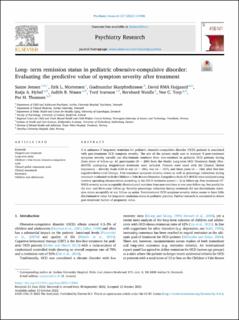| dc.contributor.author | Jensen, Sanne | |
| dc.contributor.author | Mortensen, Erik L. | |
| dc.contributor.author | Skarphedinsson, Gudmundur | |
| dc.contributor.author | Højgaard, David RMA | |
| dc.contributor.author | Hybel, Katja A. | |
| dc.contributor.author | Nissen, Judith B. | |
| dc.contributor.author | Ivarsson, Tord | |
| dc.contributor.author | Weidle, Bernhard | |
| dc.contributor.author | Torp, Nor Christian | |
| dc.contributor.author | Thomsen, Per H. | |
| dc.date.accessioned | 2023-05-05T11:46:22Z | |
| dc.date.available | 2023-05-05T11:46:22Z | |
| dc.date.created | 2022-11-15T14:15:11Z | |
| dc.date.issued | 2022 | |
| dc.identifier.citation | Psychiatry Research. 2022, 317 1-9. | en_US |
| dc.identifier.issn | 0165-1781 | |
| dc.identifier.uri | https://hdl.handle.net/11250/3066459 | |
| dc.description.abstract | It is unknown if long-term remission for pediatric obsessive-compulsive disorder (OCD) patients is associated with post-treatment OCD symptom severity. The aim of the present study was to evaluate if post-treatment symptom severity cut-offs can discriminate remitters from non-remitters in pediatric OCD patients during three years of follow-up. All participants (N = 269) from the Nordic Long-term OCD Treatment Study (NordLOTS) undergoing stepped-care treatment were included. Patients were rated with the Clinical Global Impression – Severity Scale (CGI-S) one (n = 186), two (n = 167), and three years (n = 166) after first-line cognitive-behavioral therapy. Post-treatment symptom severity scores as well as percentage reductions during treatment evaluated with the Children's Yale-Brown Obsessive-Compulsive Scale (CY-BOCS) were analyzed using receiver operating characteristics according to the CGI-S remission scores (< 2) at follow-up. Post-treatment CY-BOCS severity scores acceptably discriminated remitters from non-remitters at one-year follow-up, but poorly for the two- and three-year follow-up. Severity percentage reduction during treatment did not discriminate remission status acceptably at any follow-up point. Post-treatment OCD symptom severity status seems to have little discriminative value for long-term remission status in pediatric patients. Further research is warranted to detect post-treatment factors of prognostic value. | en_US |
| dc.language.iso | eng | en_US |
| dc.publisher | Elsevier | en_US |
| dc.rights | Navngivelse 4.0 Internasjonal | * |
| dc.rights.uri | http://creativecommons.org/licenses/by/4.0/deed.no | * |
| dc.title | Long- term remission status in pediatric obsessive-compulsive disorder: Evaluating the predictive value of symptom severity after treatment | en_US |
| dc.title.alternative | Long- term remission status in pediatric obsessive-compulsive disorder: Evaluating the predictive value of symptom severity after treatment | en_US |
| dc.type | Journal article | en_US |
| dc.type | Peer reviewed | en_US |
| dc.description.version | publishedVersion | en_US |
| dc.source.pagenumber | 1-9 | en_US |
| dc.source.volume | 317 | en_US |
| dc.source.journal | Psychiatry Research | en_US |
| dc.identifier.doi | 10.1016/j.psychres.2022.114906 | |
| dc.identifier.cristin | 2074340 | |
| cristin.ispublished | true | |
| cristin.fulltext | original | |
| cristin.qualitycode | 1 | |

